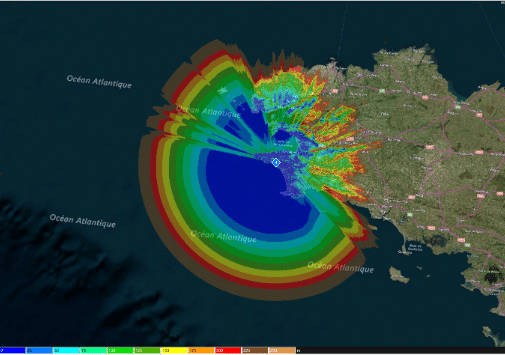With the second quarter of the year behind us, the team continues to deliver software and training and is actively engaged in projects involving the HTZ Web API. This cutting-edge solution seamlessly integrates HTZ into larger systems via a web service, supporting tactical mission planning in automation mode.
Our September webinar will showcase the API's capabilities in automating counter-drone mission operations, focusing on localisation and UAV jamming. It will also demonstrate ICS Monitoring capabilities for EMS monitoring and target emission analysis, providing real-time situational awareness. Registration is now open for two sessions to accommodate EU/US time zones.
In this month’s publication, we feature updates from our customers: the Colombian Maritime agency, DIMAR; and SANDETEL, the Andalusian Government organisation using HTZ to manage critical communications infrastructure. Also included are the latest HTZ updates including a short video demonstration, map data releases, and News in Brief.
Congratulations to Dr. Haim Mazar, ATDI’s ITU representative, who has been appointed Vice Chair of ITU-R Study Group (SG) 3 Radiowave Propagation. Dr Mazar will contribute to the SG3 four working parties and serve in the R SG1 as a Rapporteur for the 2026 Monitoring Handbook. Dr. Mazar has actively participated in the ITU-R for over three decades, providing expertise across various areas.
From the ATDI team.
Explore the new features in this month's release: HTZ v.2024.6. Users can access the latest release through the customer portal.
Network Interference: Menu: Coverage / Network Interference / IRF mode - Coverage Degradation Map: Displays interfered areas with 255 code where a given server is interfered. Interference on a given point is occurring when the Wanted signal level - Threshold degradation < Coverage Threshold. If there’s no interference, the received level from the best server is displayed.
I/N Map: Computes the I/N achieved first on the points covered by each station. And then displays the max I/N value.
C/I Degradation Map: Computes C/I degradation (C/I_after - C/I_before), with: C/I_before: C/I map created from activated stations only. The max C/I value achieved on each point is kept. C/I_after: C/I map created from activated and deactivated stations. Deactivated stations are unwanted only. The max C/I value achieved on each point is kept.
Propagation Models/Calculations: Sound Coverage:
Option to consider radiated power from stations and subscribers. If activated, the radiated power from stations or subscribers will be considered. The radiated power in W is converted to Sound power level in dB relative to 1 pW. NB: Only transmitting objects are considered. For other objects (DF, CCTV, ...), the global Sound power level will be considered.
Mobile: Menu Object / Updated Parameters / Device assignment from station Erlang: Assigns channels for each active Tx from Erlang values set in parameters, offering an alternative way to assign the number of transmitting channels according to traffic demand in Erlangs.

Check out the latest cartographic datasets released. These royalty-free datasets are a valuable addition to your cartographic toolkit and are accessible to the customer portal. Here's a summary of the data resolutions and their locations:
1m resolution – DTM/Clutter/Buildings: Tahiti. Germany: Illmenau. USA: Salt Lake City Intl Airport (UT).
2m resolution – DTM/Clutter/Buildings: Sweden: Katrineholm.
10m resolution – DTMClutter: Canada: Labrador City. Sweden: Katrineholm.
20m resolution – DTM/Clutter: Sweden: Katrineholm.
We continually refresh our map data library to guarantee your access to the most current maps. Stay tuned for updates!

The Maritime Authority of Colombia (DIMAR) turns to ATDI to manage coverage for its maritime communications systems.
Using HTZ Communications, coverage is analysed for Traffic Control and Maritime Surveillance Stations to ensure compliance with standards set by the IMO and ITU for Maritime Mobile Service frequency bands.
Historically, DIMAR relied on coverage estimates, often provided by equipment suppliers. With HTZ Communications, they achieve more reliable and realistic technical analyses which significantly enhances the planning and justifications for investments to expand capabilities. Dedicated features for the maritime market enable them to define navigation zones A1, A2, and A3, structure legal frameworks, and generate reports for the IMO. HTZ guarantees technical precision and security in the expected results.
ATDI collaborates with their local partner, TES America, which manages sales and support across the region.

EU FEDER funding for the southern Spanish region of Andalusia enabled SANDETEL to purchase HTZ Communications to update their public safety networks.
In a drive to improve critical communications, local agent SANDETEL, who manages public networks across the region, will use HTZ Communications to support Digital Mobile Radio (DMR) network planning and optimisation. Initially, they will assess network coverage across the region by importing the existing network and drive test measures, identifying not-spots and analysing DMR coverage on a surface area and point-to-point basis. Later, HTZ will be used to expand and optimise these networks by leveraging the automated frequency assignment function. The team will analyse and mitigate the impact of network interference.
DMR is the chosen technology for many emergency service providers in the region, covering fire, police, ambulance and other key services.

ARCEP: French National regulator
ARCEP enlisted ATDI to provide a centralised platform, ICS Portal, for spectrum coordination. This user-friendly web service oversees all radio devices and manages frequency requests, integrating existing channel allocations. ICS Portal coordinates between radio equipment and existing systems to maintain service reliability.
CRAM – Namibia National regulator
CRAM has upgraded to the latest version of HTZ Communications. In addition to receiving training on the latest version, CRAM has access to a comprehensive maintenance contract providing support and access to software updates and the ATDI map data library. Their training will cover importing and managing data from spectrum monitoring stations, enabling CRAM to analyse sensor locations and simulate coverage effects.



